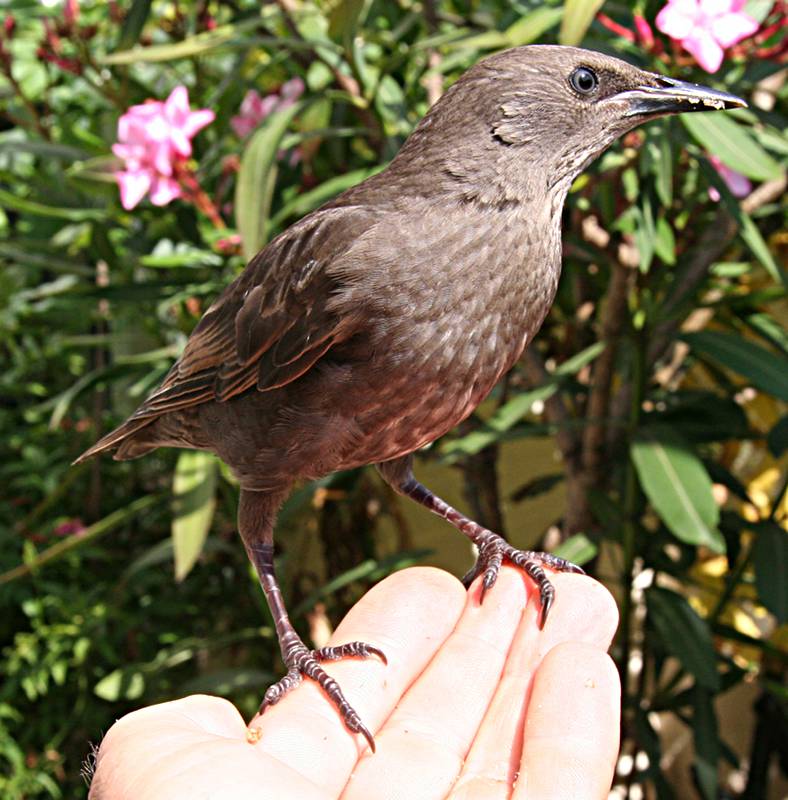 Date: 2014 July 24
Date: 2014 July 24
In 2012, I found that young starlings in the garden easily become hand-tame if encouraged with food, so I've tempted one or more in the years since.
This page features the starlings in 2014, and through to 2018 and onwards.
See the main page for notes and photos for other years.
Latest news (2018 July 4th) further down the page.
In 2014, starlings nested in 2 (maybe all 3) of the boxes I'd put up for them, so there were plenty of youngsters around. In fact so many, together with the adults, that I thought maybe none would become tame - there were always adult birds around, which (perhaps wisely!) take fright if I approach, and the young ones follow their example. But eventually two of the young ones became more bold, and the adults left them to fend for themselves.
 Date: 2014 July 24
Date: 2014 July 24
First hand-tame young starling of 2014. Writing this a few months later, I can't remember
how I arrived at a name, but being a female (probably, with light-grey iris) she become "Stacey",
I think just because of the 'St...' alliteration with starling.
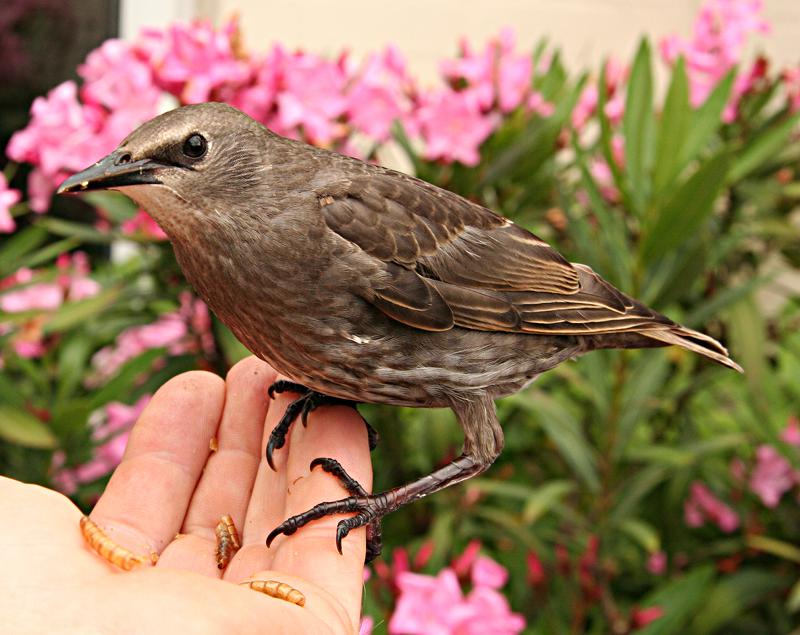 Date: 2014 July 28
Date: 2014 July 28
As in the 'news' below, a 2nd young starling became hand-tame. This one is probably a male, with brown irises,
so became "Gavin". He's a bit smaller, and a lighter-grey colour than "Stacey".
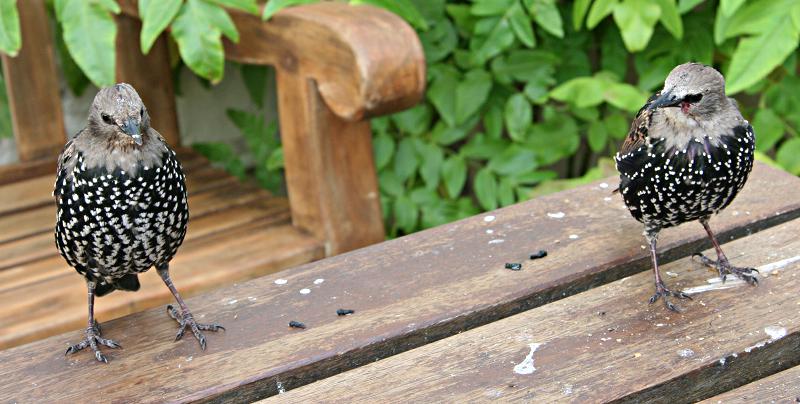 Date: 2014 September 12
Date: 2014 September 12
Six weeks later, here are "Stacey" (left) and "Gavin" (right). It's not a wound at the base of Gavin's beak - I think he's been poking it into a red juicy fruit. He's become the 'bossy' one, despite being more timid initially. Clear both now have lots of adult plumage, with just head and neck still in 'juvenile' grey.
I can usually tell them apart, even if I don't spot the colour of ths iris - slightly
different colours, perhaps Gavin is slightly smaller, and they behave differently.
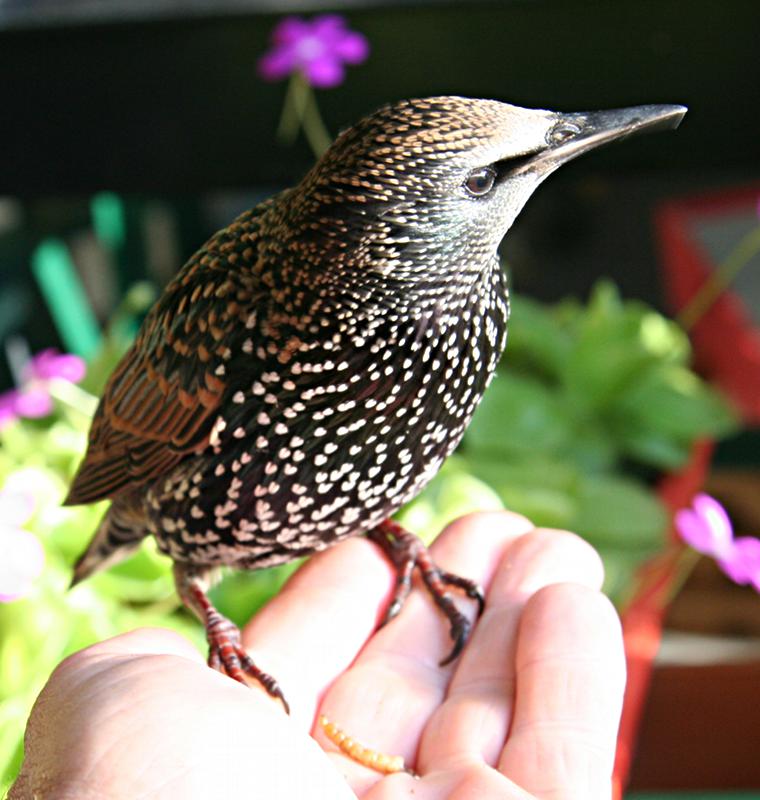 Date: 2014 October 21
Date: 2014 October 21
Both the young starlings are still visiting. Here is "Gavin" with adult plumage essentially complete.
I must try to get another photo of "Stacey".
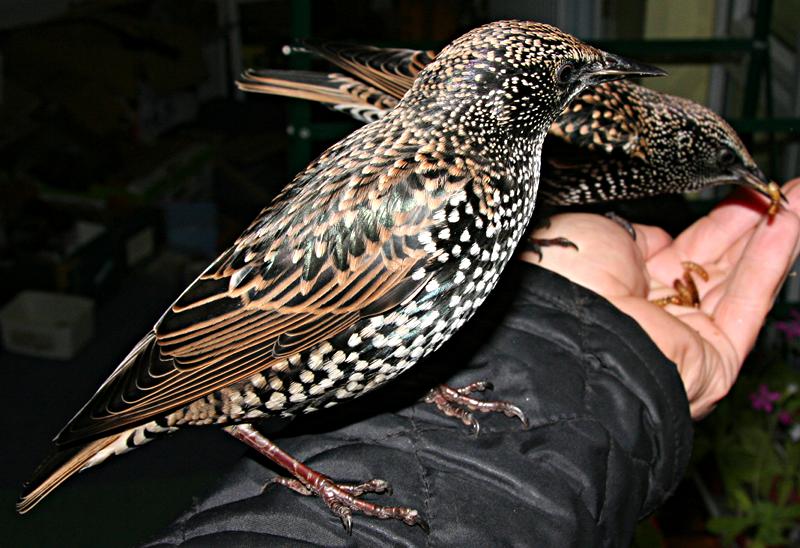 Date: 2014 October 24
Date: 2014 October 24
Both starlings at the same time. As usual, Gavin (background) is first in the 'pecking-order'. Someone else said it,
but the light-coloured ring of the iris, around the pupil, somehow gives females like Stacey (foreground) a slightly
perturbed or alarmed look (well to humans, anyway).
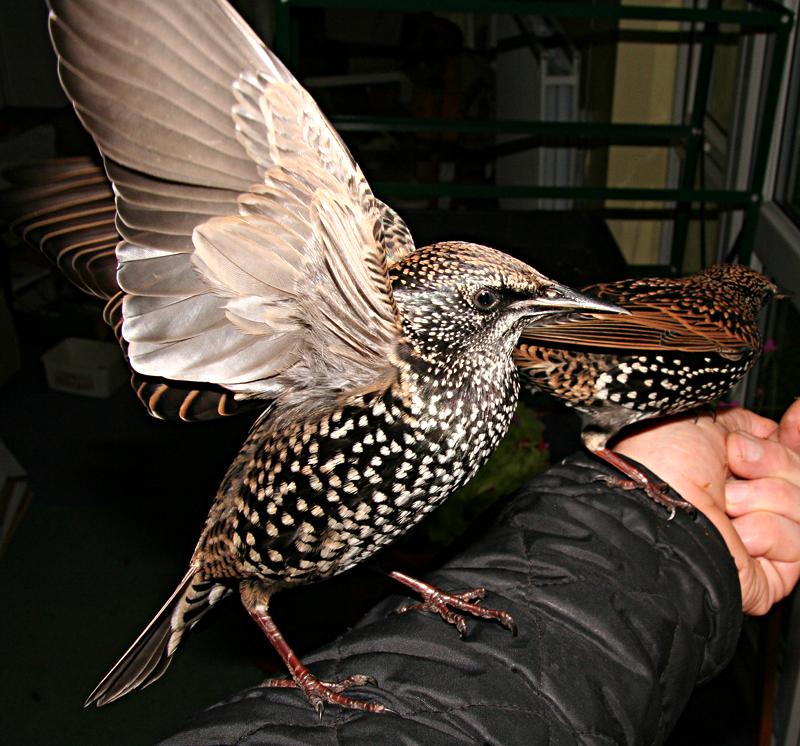 Date: 2014 October 24
Date: 2014 October 24
Being beaten to the food causes 'a bit of a flap'. Sensibly enough, Stacey usually just decides it's easier to pick up the food off the floor after Gavin has scattered it everywhere.
Gavin will usually take sultanas first, before moving on to the dried mealworms, while Stacey will only bother
with sultanas as a last resort. Both like cheddar cheese if I offer any.
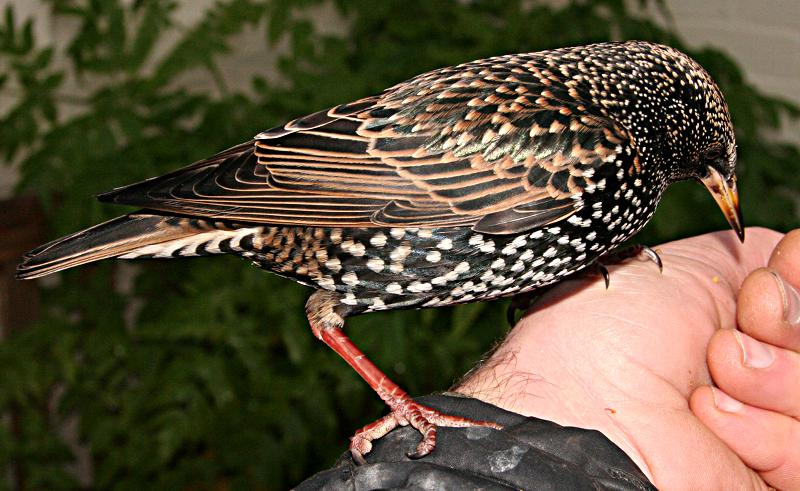 Date: 2015 January 4
Date: 2015 January 4
Stacey the starling still around into the new year. Look at the change in the colour of her beak since the last photo. Pinkish (or perhaps, as another site said, 'natural colour' - at least not blue) towards the base further indicates she's female.
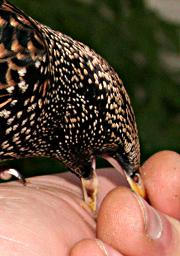
And here demonstrating that a beak designed for poking into the ground and then forcing open is just as
good for prising fingers apart to find any dried mealworms in there...
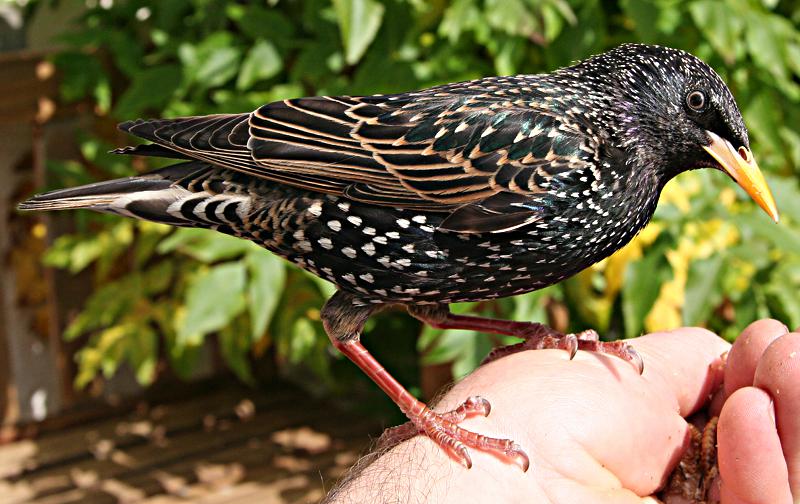 Date: 2015 April 25
Date: 2015 April 25
Stacey the starling 9 months after getting to know her as a youngster (and now she has a nest with nestlings).
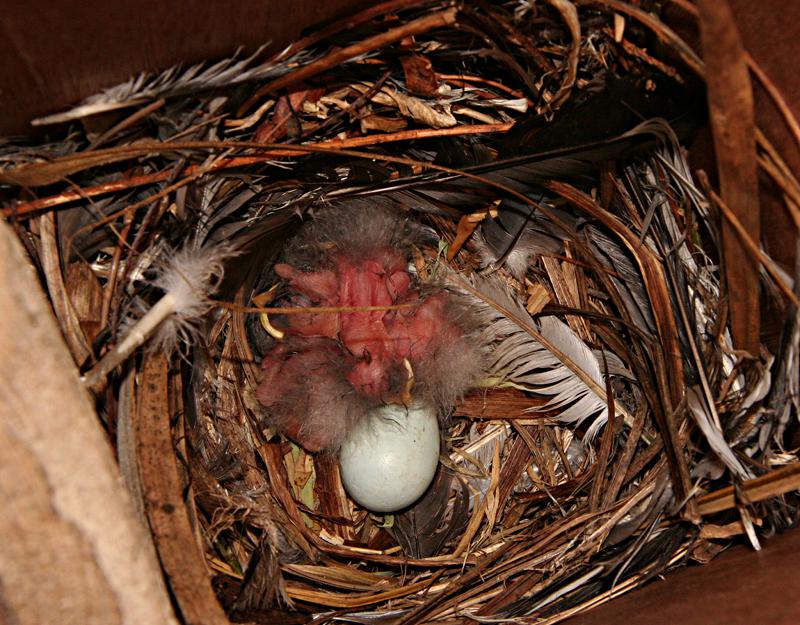 Date: 2015 April 24
Date: 2015 April 24
Stacey the starling's nest. There are 3 nestlings which hatched today, and one remaining egg, which might well
have hatched since.
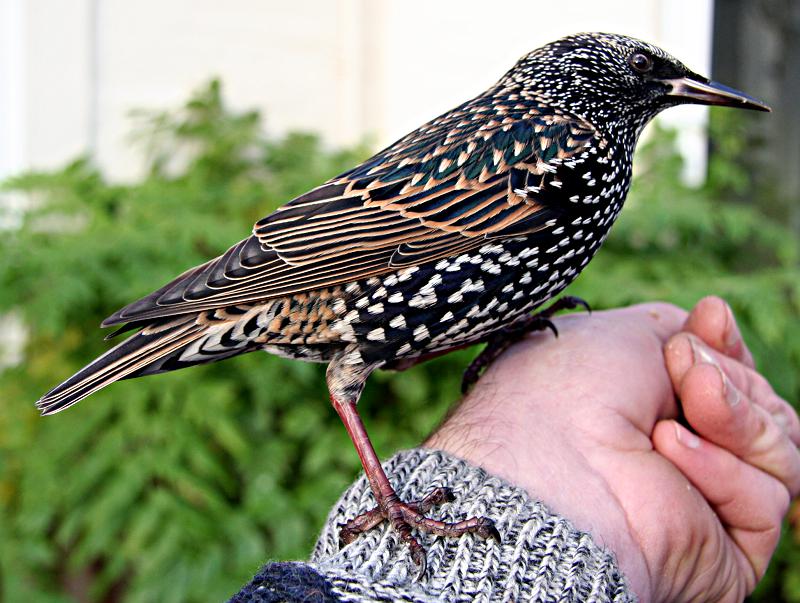 Date: 2015 November 23
Date: 2015 November 23
Time for a new photo, just to show that Stacey the starling is still around, 16 months after first
getting to know her. Now back to winter beak-colouration.
2018-July-4 Both the tame male starlings used nestboxes in the garden in spring 2018. None of the first-brood young became tame, and there have been no second broods in the garden (though maybe elsewhere). One of the two tame starlings was last seen around May 2018, leaving just the one with the toe pointing in the 'wrong' direction, so easily distinguished. I should get a photo of him, since he's now my 'record-holder' - visiting me daily for more than 2 years. Today a young one from somewhere followed him, and very nearly landed on my hand (with mealworms), encouraged that an adult starling was already doing it. So who knows - a new tame starling for 2018?
2018-January-2 By the end of 2016, there were two tame starlings - I think hatched in 2016. Both appear to be male, and I can easily distinguish them on their close visits, since one has a 'toe' which points sideways rather than forwards, so is probably fairly useless for perching. They bred in the garden in 2017, but none of the young ones became tame - I almost felt that having the tame adults around prevented me getting to know the young ones any better. The two adults are still visiting several times a day for dried mealworms and sultanas in January 2018. Their beaks are changing from 'winter' black, to 'breeding' yellow. If they are still around by March 2018, then they'll equal "Stacey" (below) in being around the garden for 20+ months.
2016-June-2 Stacey the starling stopped visiting sometime around March 2016, leaving just the tame birds which I think were her offspring to set up nests in some of the garden nestboxes. One of them doesn't really have the light-grey iris, so I was assuming a male, but she has female breeding colour at the base of the beak.
2015-December-7 I've just added the new photo of Stacey from November 2015. I'm now usually getting visits from Stacey and (I presume) two of her offspring in the morning and again before dusk. There are other starlings which come to the bird table - I wonder if one day an adult which I haven't known since being a youngster will follow the example of the others and become tame - certainly not so far. I don't know if it's because the weather is still very warm for winter, but the starlings are sometimes displaying and calling near to their selected nest-boxes, and popping in and out.
2015-November-3 In all the time since the last update, long-term tame starling Stacey was a regular visitor. For a long time, only one of her two tame offspring was visiting (at least it was never both of them at once), then both of them started turning up again. 12 days ago, I think a sparrowhawk attacked one of them - out of sight, there was some aerial squawking, and then the sparrowhawk landed on the lawn, but apparently without prey. All 3 tame starlings were back the next day, so evidently escaped harm. I've just had a period of 9 days with no tame starling visitors at all - wondering if they'd left the area - but today Stacey and one of the two offspring were back, and acting as tame as ever. Perhaps they'd just been away joining in with the large flocks of starlings which gather at this time of year.
2015-July-30 For a while, two of Stacey's offspring were coming to me regularly, then it became one, and that's the way it's stayed so far. So every day, Stacey herself, and young male (I think) "Stevie" turn up, either separately or together. If they're together, I have to act as 'referee', trying to offer mealworms and sultanas on each hand to be fair. In a squabble, Stacey defers and leaves him to it - is it because he's her offspring; just because he's young; or because he's male? Or just because it saves her from being bothered, and she can pick up scattered food from the ground anyway.
2015-June-1 3 days ago, a fortnight since fledging, Stacey and two of her young ones approached me, and for the first time, the young ones weren't scared off. One now readily takes food from my hand, and comes along without mother. A second one comes to my hand a bit more reluctantly, but chases the first one off. I think a third of the brood is usually fed by the father, who isn't so tame, so neither is the youngster yet. Of course, apart from Stacey, I can't really tell the adult starlings apart. The young ones are nearly independent now, and have already learned that self-service from the tubs of mealworms and sultanas is possible if I leave the lid off.
2015-May-23 Stacey is still taking food to the young ones, but evidently sometimes some distance away. She didn't visit often yesterday, perhaps finding it easier to find food close to where the young were.
2015-May-19 Right on schedule, at 21 days since hatching, at least one of Stacey's young fledged on 2015-May-15, and there was still at least one in the nest. The next day, at least two had fledged. Since then I think I've seen her feeding 3 together, but perhaps will never know whether all 4 fledged successfully. Stacey is taking food to them, sometimes in adjacent gardens. Right from the start, they were flying around, and perching up trees. They seem to have the usual instinctive fear of me - couple of times, one has followed its mother and come close, but then retreated again. I wouldn't be surprised if they become more tame eventually.
2015-April-29 I took a look in the nestbox and saw all 4 chicks. Stacey is managing to take occasional beak-fulls of dried mealworms and sultanas to the chicks, and is also often finding leatherjackets in the lawn. Her mate is approaching me a bit closer.
2015-April-26 2 days ago (2015-Apr-24) I saw that 3 of "Stacey" starling's 4 eggs had hatched (they hadn't the previous day). The 4th egg hatched later, and I predict fledging on 2015-May-6. Stacey still comes to me for mealworms and sultanas a few times a day, but is no doubt finding other food to take to the nestlings. I don't often see her mate - but the nestbox isn't in view from the house, and of course he isn't tame. Took new photos (above), both Stacey herself again, and the nestlings.
2015-April-13 "Stacey" starling now has a mate and a nestbox in the garden. The other two starling boxes are occupied as well. I participate in the Nest Record Scheme of the British Trust for Ornithology, so thought I'd check on Stacey's nest. She knows me so well, I think she'd practically have 'shown me round', anyway she perched about a foot away watching what I was doing - there are 4 eggs. Clutch size is reported to be 4-6, and incubation time 12 days. Perhaps I'll check again in a few days to see whether there are more eggs, or whether the clutch is complete. Her mate doesn't know what to make of me - he's certainly not tame. I'm waiting for the chance to get a good photo of him - I've got one, but it's rather poor.
Being able to follow one starling from fledging to breeding has established that this one never 'migrated' far from the garden where it fledged, and is breeding at the age of 9 or 10 months.
2015-March-6 Still nothing new to report. "Stacey" starling is still visiting several times a day, and I suspect is never very far from the garden. I saw her carrying some potential nesting-material today, but no sign that she's worked out what to do with it - she took it onto the bird-table and played with it for a while. Anyway, as a female, she's supposed only to complete a nest that a male has started, so she doesn't need to build a nest 'from first principles'. I've now got a male blackbird which will perch on my hands eating sultanas, so there's sometimes competition - starling on one hand and blackbird on the other keeps them from arguing too much!
2015-January-26 Time for an update, even though there's nothing new. "Stacey" starling is still visiting for food daily.
2015-January-4 "Stacey" starling is still visiting daily. Her beak is taking on adult colouration - pinkish at the base is further evidence of her being a female, and some of the males are developing the bluish colour.
2014-December-20 For a few days now, I've only had one visiting tame starling - "Stacey" the likely female. She often seems to be hanging around with a non-tame bird.
2014-December-8 Both tame starlings are still visiting regularly. Together with other non-tame ones, they are often investigating the various nest-boxes in the garden - I don't know whether with nesting in a few months time in mind.
2014-November-29 Both tame starlings are still visiting. Most often they both come first thing in the morning, and (as usual) "Gavin" bullies "Stacey" over the food. But he flies off once he's had enough, and leaves her to it. Usually just Gavin calls back later in the day, with last visit just before the starlings fly off to wherever it is they go to roost for the night.
2014-October-20 I'd been away, so hadn't seen the starlings for 3 days, but they quickly appeared when I opened the door the next morning. This is a lot later in the year than I've still had tame starlings visiting in the last two years, but then I only got to know these ones later in the year. I hope they stick around for winter, just so I can follow their development.
2014-September-12 Both the starlings are still visiting regularly, and their adult plumage is quickly developing. One day, "Stacey" turned up with a tick attached, but it had dropped off by the next day. I don't know how long it takes a tick to swell to full size, feeding on blood, but I guess I only see them when approaching the time they drop off.
2014-July-30 A 2nd young starling has now become hand-tame after spending days coming closer and closer. This one is smaller and more 'grey' than the 'brown' of the first one. With my newly discovered information (see main page) about determining whether male or female, I think the first one is female, and this new one male. "Stacey" and "Gavin" I reckon - the first because the "St..." seems appropriate for a starling, and the other because I just knew there was some kind of TV serial (I had to look up what it was about). They fight if present at the same time, though so long as I have some mealworms in each hand, then they'll tolerate one being on each hand.
2014-July-24 In 2014, starlings nested in at least two of the three boxes I'd put up for them. I didn't manage to 'tame' any of the first-brood youngsters - perhaps happy with their own company as there were so many, and the adults birds would scare them away with 'alarm' behaviour if I approached. But a few days ago, one of the youngsters, probably 2nd brood from a nest outside the garden, became more bold, and has now been hand-tame (so long as dried mealworms are provided!) for a few days. It's not so far a fan of the blackbirds' favourite sultanas, but some of the other starlings like them. It's as feisty as ever, for a small young bird, being happy to challenge even adult blackbirds over food (but it has to back down sometimes!).